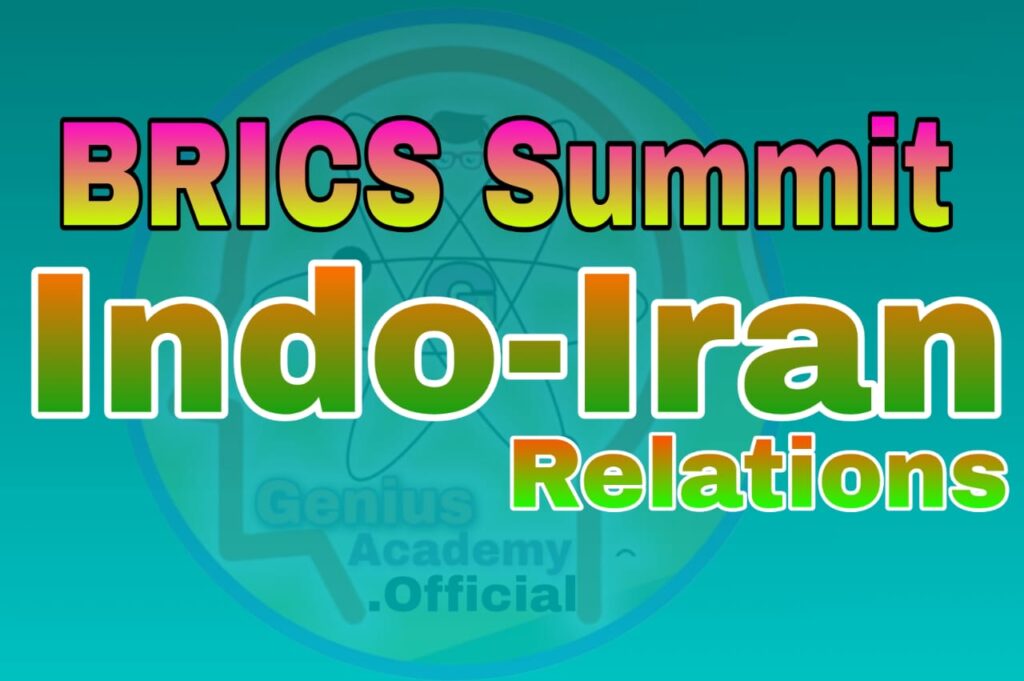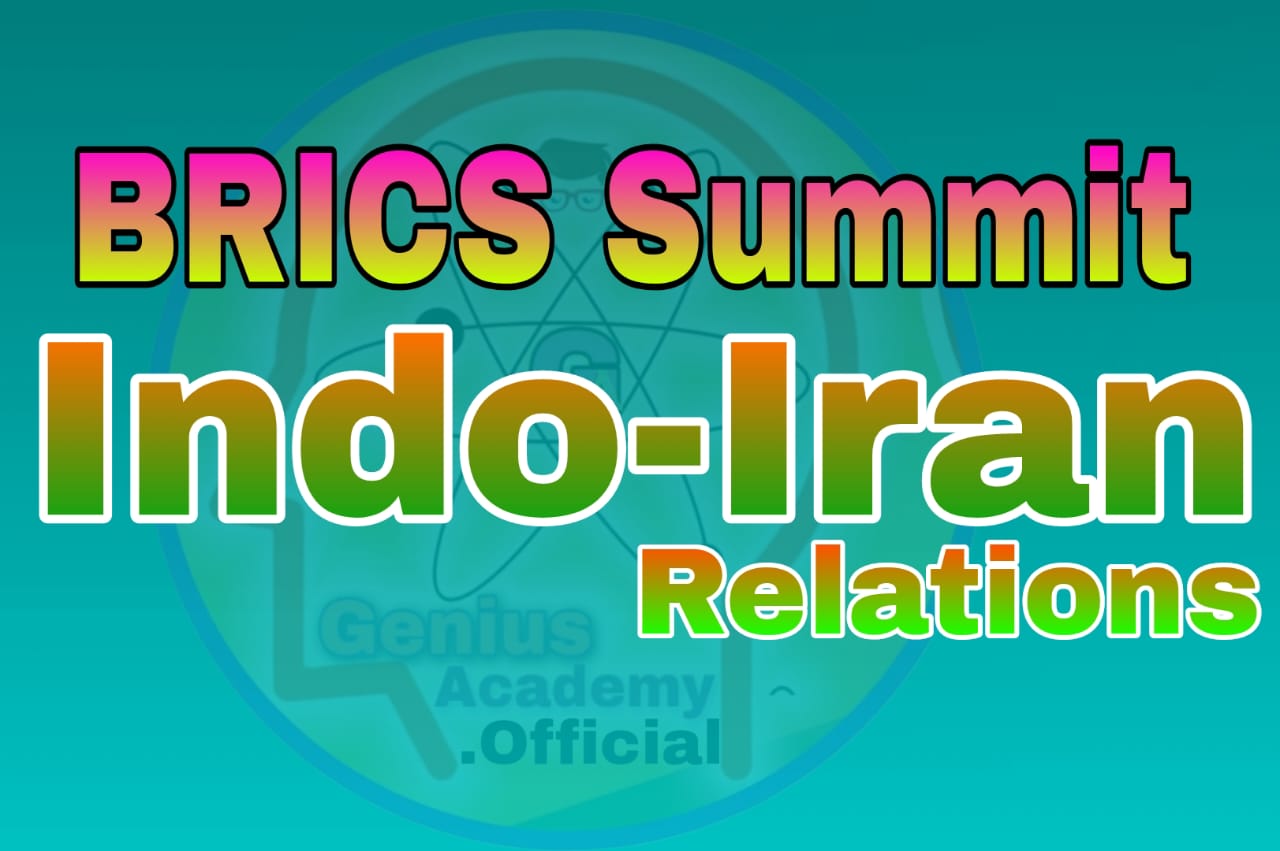
1. Background: The BRICS Summit and India-Iran Relations
1.1 16th BRICS Summit Meeting
- Held in Kazan, Russia, from October 22-24, 2024, this summit saw important discussions on global cooperation among member countries.
- A key highlight was the meeting between Indian Prime Minister Narendra Modi and Iranian President Masoud Pezeshkian, sparking interest in strengthening the India-Iran partnership, which had been static for some time.
1.2 Importance of India-Iran Relations
- Civilizational Bonds:— India and Iran share centuries-old cultural and historical ties, serving as a foundation for modern diplomatic relations.
- Geopolitical Context:— The recent escalation of the Gaza conflict has drawn Iran’s interest in seeking India’s support for de-escalation, recognizing India’s unique position as a trusted partner of both Israel and Iran.
2. Untapped Potential in India-Iran Relations
2.1 Acknowledgment by Leaders
- The meeting between Modi and Pezeshkian highlighted the untapped economic, strategic, and diplomatic potential in India-Iran relations.
- Iran’s President appreciated India’s international role and suggested it could contribute to the Gaza crisis’s peaceful resolution.
2.2 Iran’s Multilateral Entry Supported by India
- Iran joined major multilateral bodies like the Shanghai Cooperation Organisation (SCO) and BRICS, with India playing a supportive role in these entries.
3. Key Areas of Cooperation
3.1 Chabahar Port and the International North-South Transport Corridor (INSTC)
- Strategic Importance of Chabahar:— India and Iran signed a 10-year agreement in May 2024 for operational control over the Chabahar port, enhancing India’s connectivity with Central Asia and Afghanistan.
- Bypassing the Strait of Hormuz:— Located outside the Persian Gulf, Chabahar offers India a strategic advantage by allowing trade without passing through the potentially volatile Strait of Hormuz.
- Upcoming Rail and Road Connectivity:— A 700 km railway linking Chabahar to Zahedan is in development, which, when extended, will connect to Iran’s broader railway network. Plans for a road from Zahedan to Zaranj in Afghanistan would facilitate humanitarian assistance to Afghanistan.
3.2 Energy Partnership
- Oil and Gas Reserves:— Iran has vast oil reserves of approximately 209 billion barrels and a natural gas reserve of 33,988 billion cubic meters. These reserves make Iran an essential energy partner for India.
- Resuming Oil Imports:— Iran once fulfilled nearly 12% of India’s oil needs until May 2019. A resumption of oil imports could significantly benefit India’s energy security.
- Potential Iran-Oman-India Gas Pipeline:— Proposed since 1993, this undersea pipeline could offer a direct route for natural gas from Iran and Oman to India if successfully implemented.
3.3 Defense and Security Cooperation
- Past Defense Cooperation:— Although a defense agreement was signed in 2001, it remained inactive due to sanctions on Iran. However, Iran has since developed advanced military technology, including ballistic missiles, hypersonic missiles, and drones.
- Potential for Drone Collaboration:— Iran has supplied drones to Russia, and India’s interest in cost-effective armed drones could lead to potential cooperation in this area.
- Joint Counterterrorism Efforts:— India and Iran share concerns about terrorism originating from Pakistan. Both nations could benefit from joint counterterrorism exercises and intelligence-sharing agreements.
- Naval Cooperation:— Port calls at Iranian ports and logistical bases in the Persian Gulf could provide India with strategic leverage in the region.
4. India’s Diplomatic Strategy with Iran
4.1 De-hyphenating Relations
- India maintains independent relationships with both Israel and Iran, even though the two countries are adversaries. This approach is termed “de-hyphenation,” allowing India to balance relations based on its national interests.
- India’s ability to exercise strategic autonomy has been evident, notably during the Russia-Ukraine war, where it maintained ties with Russia despite international pressures. This flexibility sets a positive precedent for Iran’s relationship with India.
- Handling Sensitive Issues:— Remarks by Iran’s Supreme Leader on India’s treatment of Muslims, comparing it to the Gaza situation, caused diplomatic tension. While the comment led to sharp responses from India, both sides recognize the importance of maintaining strong ties that serve greater bilateral interests.
- Focus on Broader Goals:— Such statements, though potentially divisive, are seen as isolated incidents. The broader trajectory of India-Iran relations remains focused on mutual benefit in strategic, economic, and cultural domains.
5. Future Outlook for India-Iran Relations
- The India-Iran relationship holds significant potential across multiple areas, from economic connectivity via Chabahar to energy imports and defense collaboration.
- With India’s diplomatic leverage and Iran’s strategic importance, both countries are poised to further their cooperation, enhancing regional stability and economic integration.
- The BRICS summit underlined a renewed commitment to realizing the untapped potential of this relationship, with a focus on pragmatic cooperation amidst regional and global challenges.
Hence, India’s multi-faceted diplomacy and Iran’s openness to closer ties provide a promising foundation for strengthening their partnership, which is increasingly relevant given the geopolitical shifts in the Middle East and beyond.
Source:— The Hindu

